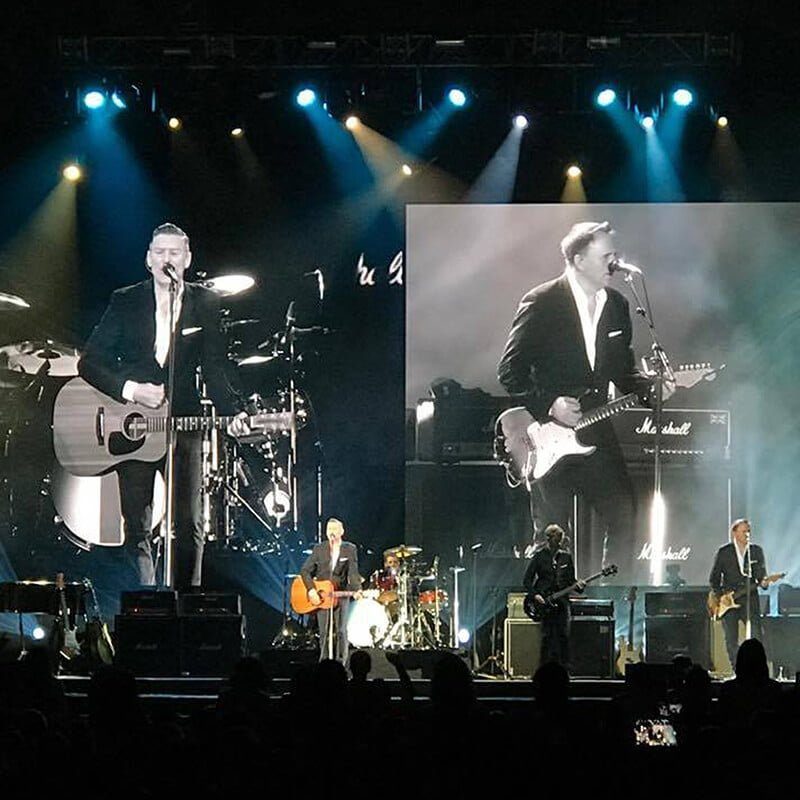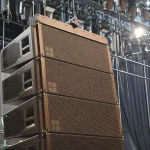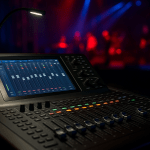Key Takeaways
- Concert sound quality: makes or breaks the experience, and selecting the right system ensures clarity, consistency, and audience immersion.
- Types of systems: (PA, line array, DJ, portable, surround, etc.) should be matched to venue size, acoustics, and event type for optimal audio delivery.
- Core components: speakers, amplifiers, mixers, and equalisers – must be calibrated to suit venue acoustics and audience size.
- Indoor vs outdoor setups: require different approaches: indoor venues need acoustic finesse, while outdoor setups must overcome environmental challenges.
- Partnering with professional sound equipment rental companies: ensures access to tailored systems, expert setup, and troubleshooting – key for a seamless concert experience.
Table of Contents
ToggleIntroduction
Concerts offer us a break from the ordinary. They evoke strong feelings, rekindle memories, and produce intensely exciting moments.
But when a concert’s sound quality is poor, it may spoil what should be an amazing experience. Distorted audio, muffled vocals – or an uneven mix – can affect the crowd’s experience. In fact, the crowd’s energy can swiftly shift from exuberance to unease.
So, how can organisers avoid poor sound quality detracting a performance? What role does the right sound system play in ensuring audience members focus and enjoy the performance rather than wishing it would end?
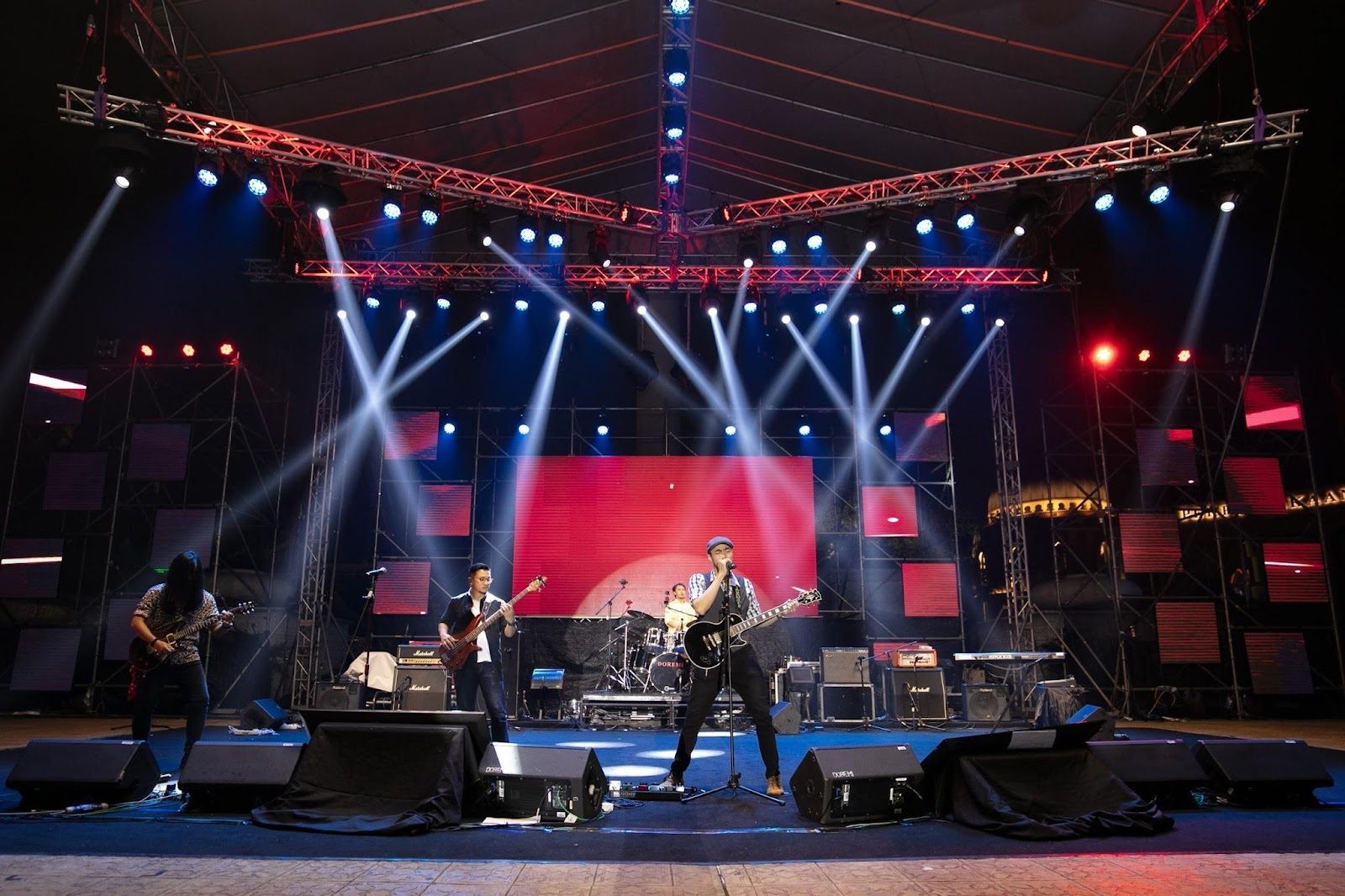
What is a concert sound system?
A concert sound system is a sophisticated setup intended to record, process, and transmit high-quality audio to a concert audience. It is composed of several essential components, each crucial to producing a clear, well-balanced, and captivating sound.
These components include sound sources, mixing consoles, amplifiers, and speakers.
Overall, a concert sound system ensures that all concert attendees experience audio with the same intensity and fidelity – regardless of their position in the venue.
Read: Complete Guide to Professional Concert Sound Systems in Malaysia.
Types of sound systems commonly used for events.
Various types of sound systems are used for events, each tailored to the distinct needs of an occasion and the venue’s size. For example:
- PA Systems (Public Address Systems): PA systems are perfect for conferences and seminars where speech amplification is required. Because of their portability and compact design, they are ideal for indoor events and smaller outdoor installations. In practice, they typically come with speakers, an amplifier, and a microphone.
- Line Array Systems: Line array systems are specifically designed for large-scale events, such as concerts and festivals. They employ speakers positioned vertically to transmit music over great distances – providing the audience with uniform coverage.
- Portable Sound Systems: Portable sound systems are commonly used at very small events like birthday parties due to their versatility and ease of configuration.
- DJ Sound Systems: These sound systems are usually seen in pubs and nightclubs. They are designed to create a loud, energetic sound with a strong bass. Subwoofers are frequently employed to amplify their low-frequency sounds.
- Surround Sound Systems: These systems utilise multiple speakers strategically placed throughout the audience to create a 360-degree sound effect. Thereby, providing an immersive experience. They are frequently used during large concerts and on movie screens.
- Wireless Microphone Systems: These provide versatility and are frequently employed in interactive sessions or dynamic presentations. In practice, they let artists and speakers move freely.
- Subwoofer Systems: These specialised speakers are designed to handle low-frequency sounds, such as bass and drums. They are essential for events with bass-heavy music.
- Stage Monitor Systems: These systems consist of small speakers positioned on the stage, allowing actors to hear themselves clearly while performing. In practice, they enable musicians to maintain consistent time and pitch.
Key components of a concert sound system
The standard concert sound system constitutes of three components, namely:
Speakers
Speakers are arguably the foundation of every concert sound system. However, the size and acoustics of the venue determine the type of speakers one should employ.
Traditional point-source speakers, which direct sound in a single direction, are often sufficient for smaller spaces. In larger venues or outdoor environments, uniform, dispersed sound over a wide area becomes crucial.
In this situation, line array speakers are mission-critical. These speakers are designed to stack vertically and work together to provide even coverage and a wider range of sound projection.
Amplifiers
In concert sound systems, amplifiers help augment the audio signal to decibel levels that are audible across the venue. Whether it’s a large stadium or a small club, the amplifier must be able to meet the speakers’ power requirements to ensure a distortion-free performance.
A less powerful amplifier may be adequate in smaller spaces because the sound doesn’t need to travel as far or occupy as much space. Additionally, amplifiers help tailor the sound to a venue’s acoustics.
For example, in spaces with poor acoustics, amplifiers can adjust frequencies to mitigate echoes or muddiness. This ensures that the sound is crisp and clear throughout the performance.
Mixers and equalisers
A mixer integrates and manages various audio inputs—including backing tracks, instruments, and vocals—to produce a well-balanced, unified sound. In practice, sound engineers use the digital mixer to make real-time adjustments to levels, panning, and effects.
In live settings, where room acoustics can greatly impact sound quality, this is extremely crucial.
An equaliser can boost or reduce specific frequencies to create a more balanced sound that suits a particular setting, such as in venues with harsh mid-range or booming low frequencies.
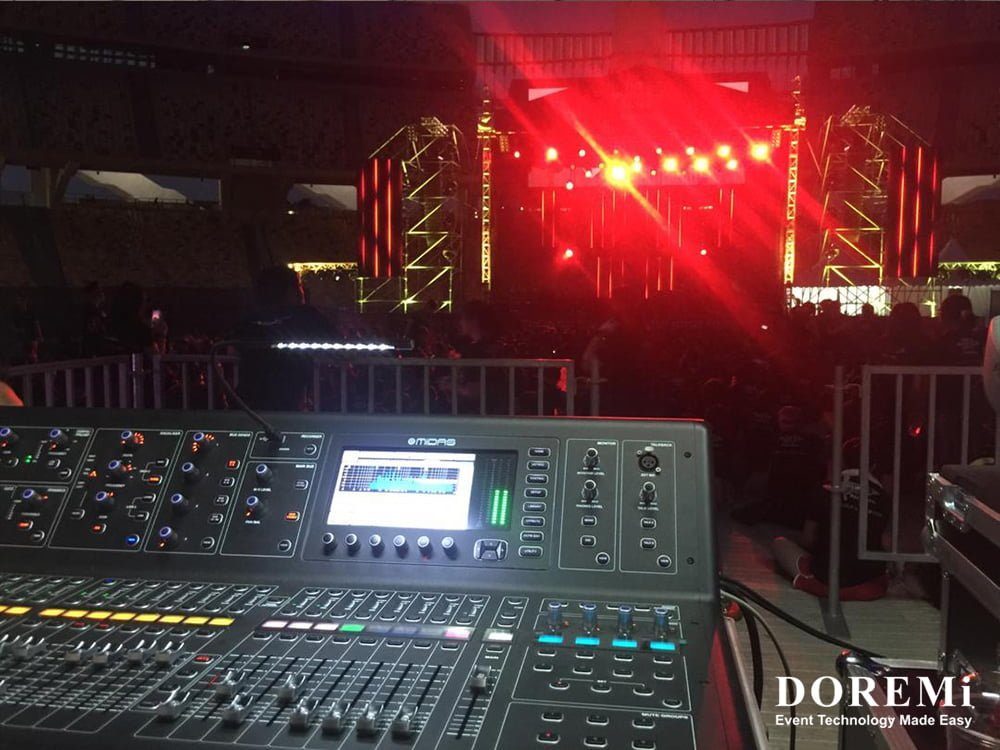
Factors to consider before choosing a concert sound system
When selecting a concert sound system, several key metrics should be considered to achieve optimal sound quality and maximum concertgoer satisfaction.
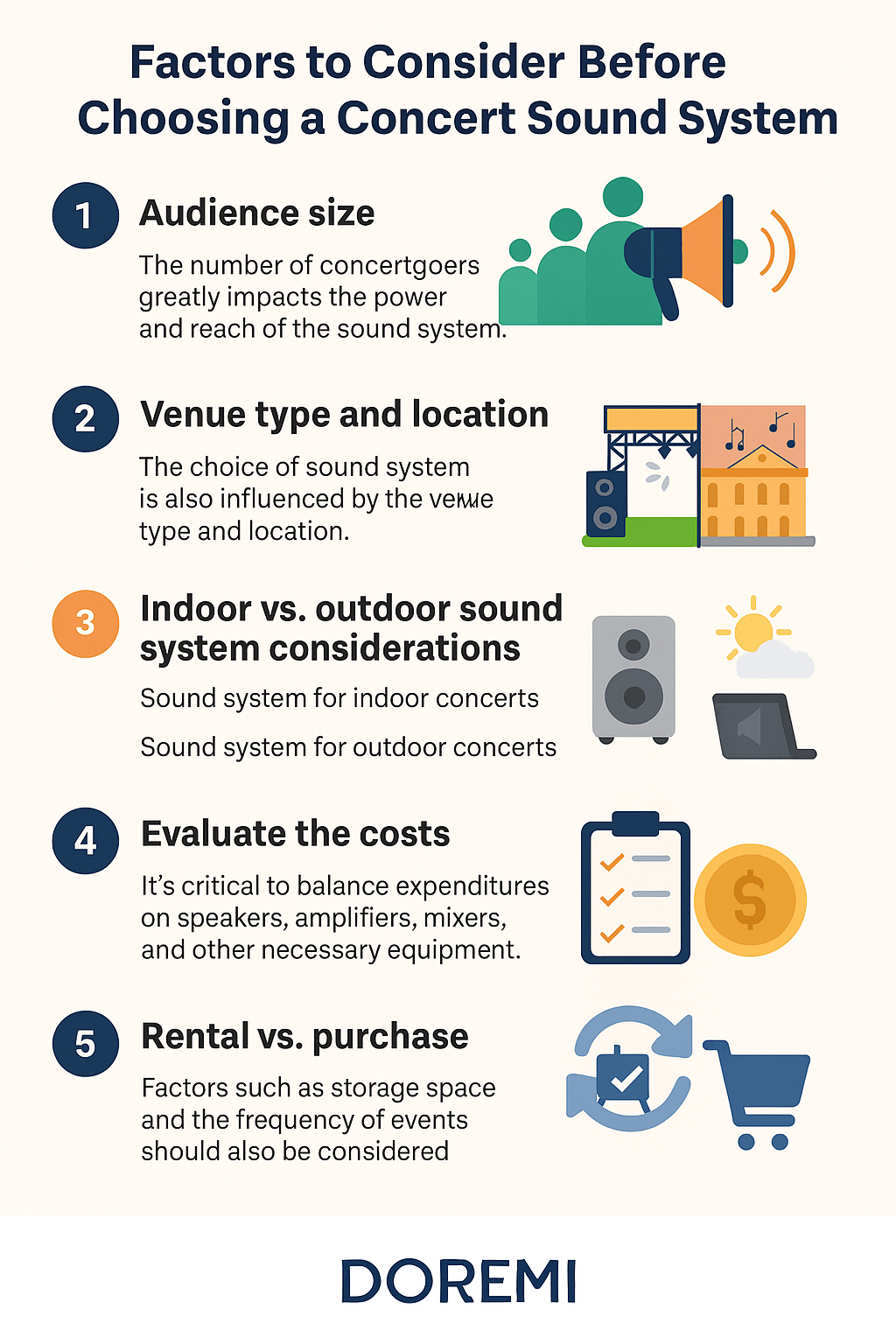
1. Audience size
The number of concertgoers greatly impacts the power and reach of the sound system. Professional-grade systems with multiple speakers and higher wattage are often necessary for larger crowds to provide comprehensive coverage. However, a small gathering might employ a simple PA system.
2. Venue type and location
The choice of sound system is also influenced by the venue type and location, due to varied elevations and acoustics. For context, open-air areas require systems that can project sound over great distances without relying on walls for reflection. At the same time, concert halls often necessitate systems that can manage the nuanced acoustics of the environment.
3. Indoor vs. outdoor sound system considerations
Due to their varying heights and acoustics, Malaysian outdoor venues such as stadiums and amphitheatres present unique challenges for sound systems.
For example, uneven terrain and a lack of walls to reflect sound in stadiums and amphitheatres can lead to uneven sound coverage. This often necessitates the use of directional speakers or line arrays to direct sound toward the audience.
Sound system for indoor concerts
Sound dispersion in enclosed settings, speaker positioning, and room acoustics must all be carefully considered for indoor concerts. The sound system must be tailored to the venue’s architecture to prevent problems like dead spots or echoes. Fortunately, these issues can be resolved with careful main and fill speaker arrangement.
Sound system for outdoor concerts
Environmental factors, such as heavy winds, humidity, and temperature fluctuations, can impact sound quality over large areas. Speaker placement and equalisation settings must be optimised to compensate for these elements. Additionally, if you’re in an area with unpredictable weather, ensure you hire weather-resistant equipment.
4. Evaluate the costs
It’s critical to balance expenditures on speakers, amplifiers, mixers, and other necessary equipment. In practice, the type of venue and audience size significantly impact sound system budgets. Larger venues require more powerful systems – consisting of line arrays – which raises the event budget.
5. Rental vs. purchase
Renting equipment is advantageous for one-time events. This is because it provides access to the latest technology without requiring ongoing maintenance. For frequent use, buying can be more economical and offer control over the maintenance and quality of the equipment.
Factors such as storage space and the frequency of events should also be considered when deciding between owning and renting.
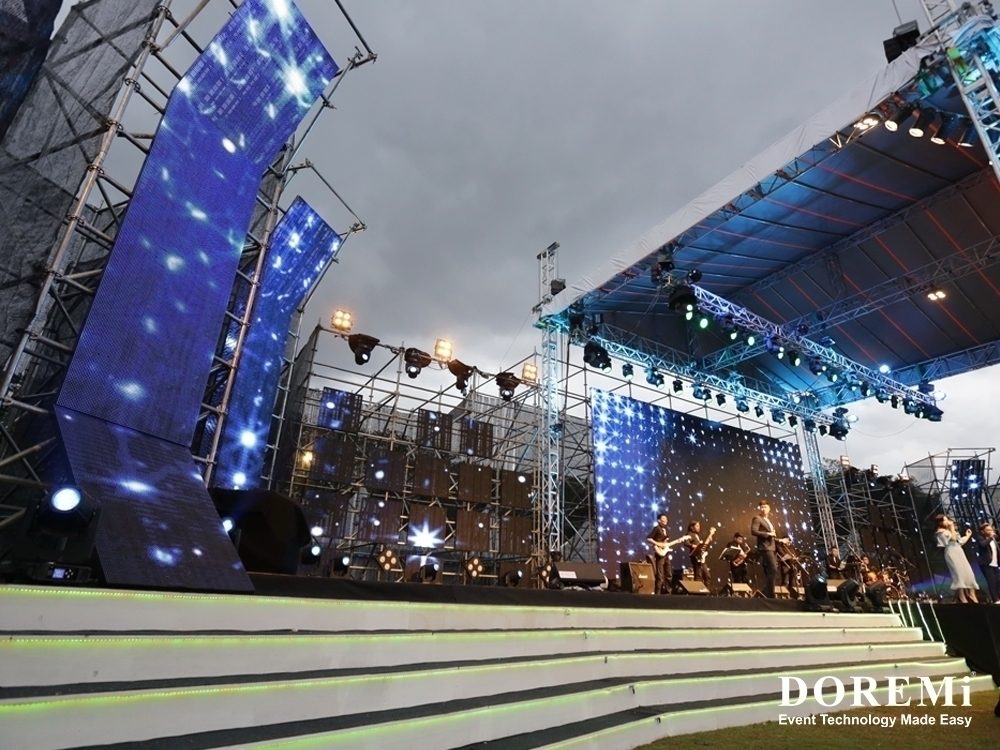
Why partner with a professional sound system rental company?
A professional sound system company offers several benefits to enhance the calibre and success of your event. For instance:
- Knowledge and equipment quality: They offer premium sound systems that are regularly updated and maintained to ensure peak performance. Furthermore, their staff comprises seasoned sound engineers who know how to set up and run the equipment properly. These experts are prepared to address any technical issues that may arise during the event, minimising downtime.
- Tailored solutions: Professional rental companies can install sound systems specifically tailored to your concert’s nuanced needs. For instance, the size of the venue, the arrangement of the crowd, and the type of music being performed.
- They may modify their products to meet the unique acoustic requirements of the event—whether it’s a large outdoor festival or a small indoor gathering.
Where to get a concert sound system in Malaysia?
DOREMi is among the top companies for concert sound system rentals in Malaysia. We provide a wide range of services, including other event sound system rentals, customised to meet the demands of unique events. With a staff of skilled sound engineers and a vast inventory of equipment, we can accommodate last-minute requests and deliver exceptional audio experiences.
As a one-stop shop for event planners, we offer an extensive range of services, including LED screens, lighting, event production, and sound systems.
Conclusion
Concerts are exhilarating events that captivate audiences and leave lasting impressions. They can elevate emotions and create unforgettable moments. However, when the sound is subpar, it can disconnect the audience from the performance.
Several key criteria must be considered when renting a sound system to ensure the best possible audio experience. The concert’s size is important, as larger crowds require more powerful systems to ensure thorough coverage.
Another important factor is the type of venue. For example, outdoor venues require systems that can project sound over long distances. Furthermore, the budget is a crucial factor.
Overall, the ideal concert sound experience can be achieved by consulting with knowledgeable sound suppliers who can tailor solutions to meet specific requirements.
In Malaysia, DOREMi can help deliver a captivating audio experience for your audience. Whether it’s a small indoor gathering or a big outdoor festival, do not compromise with sound quality! Reach out for a consultation.

